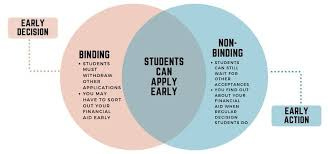With the next application cycle approaching, many rising seniors are trying to strategize correctly…
Which often means choosing which school(s) to apply to early.
However, even knowing that isn’t enough because there are different options during the early application cycle.
To help you make the best decision for your future, here’s a breakdown of the different early application processes and their implications.
Restrictive Early Action (REA) means you can only apply early to that particular college, but you’re not required to attend if admitted. This is common among Ivy League schools like Yale. REA allows you to demonstrate your strong interest in a school without committing to attending, enabling you to consider other options if accepted.
Early Action (EA) Early Action is a non-binding option where you apply by November and receive a decision by December. You’ll either be admitted, rejected, or deferred to the regular application pool. Being deferred means the college wants to see how you compare to the other applicants before making a final decision, so you still have a chance for admission.
Early Decision (ED) Early Decision is a binding agreement. If you’re admitted, you’re obligated to attend. Colleges increasingly favor this option because it boosts their yield rate—the percentage of admitted students who enroll.
For instance, the University of Pennsylvania, an Ivy League school with the top-ranked business program in the country, filled 51% of its incoming class through Early Decision.
ED1 vs. ED2 There are two rounds of Early Decision:
ED1: Applications are due in November, similar to other early application timelines.
ED2: Applications are due in January, aligning with regular decision timelines. ED2 offers another opportunity to demonstrate your commitment to a college if you weren’t admitted in the first round.
If you have a clear first-choice school, applying early can significantly increase your chances of admission.
The commitment required by Early Decision shows colleges you’re serious about attending, which can give you an edge.
Remember, each option has its pros and cons.
Understanding and aligning these differences with your college preferences and goals is critical to a successful application strategy.
Early decision (ED) and early action (EA) plans can benefit students who have carefully considered their college options and have a clear preference for one institution.
Counselors need to make sure that students understand the critical distinction between the two plans:
Early decision plans are binding: A student accepted as an ED applicant must attend the college.
Early action plans are nonbinding: Students receive an early response to their application but only have to commit to the college on the expected reply date of May 1.
Approximately 450 colleges have early decisions or action plans, and some have both. Some colleges offer a nonbinding option called single-choice early action, under which applicants may not apply ED or EA to any other college.
ED plans have been criticized as unfair to students from families with low incomes. Since they do not have the opportunity to compare financial aid offers, this may give an unfair advantage to applicants from families with more financial resources.
ED Applicants
Apply early (usually in November) to first-choice college.
You will receive an admission decision from the college well in advance of the usual notification date (usually by December).
Agree to attend the college if accepted and offered a financial aid package that is considered adequate by the family.
Apply to only one college early decision.
Apply to other colleges under regular admission plans.
Withdraw all other applications if accepted by ED.
Send a nonrefundable deposit well in advance of May 1.
EA Applicants
Apply early.
Receive an admission decision early in the admission cycle (usually in January or February).
Please consider the acceptance offer; you don't have to commit when you receive it.
Apply to other colleges under regular admission plans.
Give the college a decision by the May 1 national response date.
Apply Early
A student should apply early to an ED or EA plan if the student:
Has researched colleges extensively.
I am sure that the college is the first choice.
Has found a college that is a strong match academically, socially, and geographically.
Meets or exceeds the admission profile for the college for SAT scores, GPA, and class rank.
Has an academic record that has been consistently solid over time.
The Benefits of Applying Early
For a student who has a definite first-choice college, applying early has many benefits:
Reduces stress by cutting the time spent waiting for a decision.
It saves the time and expense of submitting multiple applications.
Gain more time, once accepted, to look for housing and otherwise prepare for college.
Please go ahead and reassess your options and apply elsewhere if not accepted.
The Drawbacks of Applying Early
Pressure to decide: Committing to one college pressures students to make serious decisions before they've explored all their options.
Reduced financial aid opportunities: Students who apply under ED plans receive offers of admission and financial aid simultaneously and cannot compare financial aid offers from other colleges. Applying early may be risky for students who need financial assistance.
Time crunch for other applications: Most colleges notify ED and EA applicants of admission on December 15. Because of the usual application deadlines, this means that if a student is rejected by the ED college, there are only two weeks left to send in other applications. Encourage those of your students who are applying early to prepare other applications as they wait to receive admission decisions from their first-choice college.
Senioritis: Applicants who learn early that they have been accepted into a college may feel that since their goal has been accomplished, they have no reason to work hard for the rest of the year. Early-applying students should know that colleges may rescind offers of admission should their senior-year grades drop.
Applying Early and the Chance of Acceptance
Many students believe applying early means competing with fewer applicants and increasing their chances for acceptance. This is only sometimes true. Colleges vary in the proportion of the class admitted early and the percentage of early applicants they accept.
Higher admission rates for ED applicants may correlate to more robust profiles among candidates choosing ED. Students should ask the admission office whether their institution's admission standards differ between ED and regular applicants and assess whether applying early makes sense, given their profile.
The Ethics of Applying Early Decision
The Common Application and some colleges' application forms require the student applying under early decision and the parent and counselor to sign an ED agreement form spelling out the plan's conditions.
In your school handbook and at college planning events, please clarify that your policy for early-decision applications is to send only the student's final transcript to one college. Is anything else unethical?
Keep in Mind
ED and EA program specifics vary, so students should get information as soon as possible from the admission staff at their first-choice college.
ED and EA applicants must take the October SAT for these scores to make it to the college in time.






